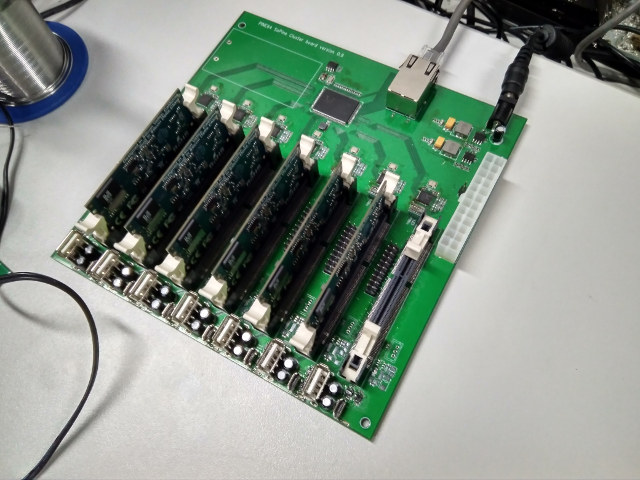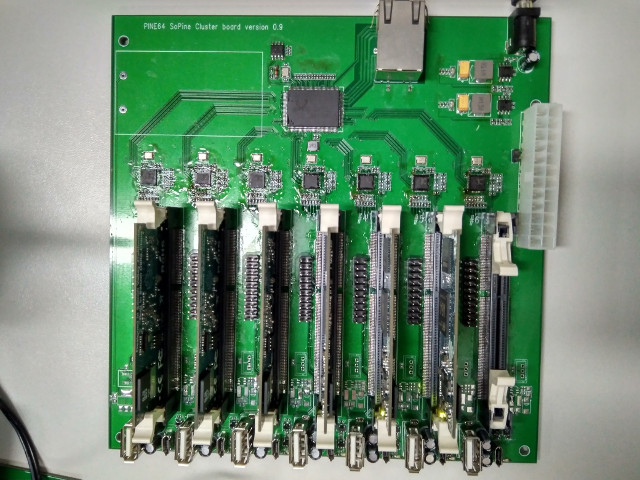Pine64 launched SOPINE A64 system-on-module based on Allwinner A64 processor back in January, with such module normally being found in low volume products where companies do not want to spent too many resources developing complex multiple layers boards with CPU and RAM, and instead focus on developing a simpler baseboard and custom software for their product. Pine64 made something else with SOPINE A64 modules: a cluster board.

I don’t have the full details yet, but “PINE64 SoPine Cluster Board” comes with 7 SO-DIMM slot designed to take SOPINE64 modules with the board providing a micro USB OTG port, a USB host port, and Ethernet transceiver for each SoM, which are connected to a Gigabit Ethernet switch (initially Marvell 88E6185, but they appear to have now switched to a Realtek part), and accessible via a single Gigabit Ethernet port.

Power can be provided by a 5V/10A power supply connected to a power barrel, or via the ATX connector.I also understand the board is based on mini-ITX form factor (170×170 mm), so you’d be able easily find a case for it.
The board and software are still being developed, and it’s unclear when/if it will launch publicly.

Jean-Luc started CNX Software in 2010 as a part-time endeavor, before quitting his job as a software engineering manager, and starting to write daily news, and reviews full time later in 2011.
Support CNX Software! Donate via cryptocurrencies, become a Patron on Patreon, or purchase goods on Amazon or Aliexpress





They still haven’t shipped Rock64 board, have been waiting for 3 weeks
I got mine 4 days ago. Ordered June 5th.
Thanks. I will keep waiting
@morning
Not true, they’ve shipped, they just had a very limited amount of boards and only 1 and 2GB boards. They’re supposed to get the 4GB ones by the end of the month.
Glad to know that, it is not long to the end of this month. Thanks
Oh! My future build farm!
Well, not exactly but in the spirit it’s the closest to what I’ve been looking for for a while and that I tried to do myself by assembling stuff manually.
Some of the good points I’m seeing :
– integrated ethernet switch, just one cable needed
– single power supply connector
– per-board USB connections easing debugging
Some of the not so good points :
– quite low frequency CPU (1.2 GHz for an A53 is dog slow, but the concept is here and can be improved)
– power supply coming in 5V. Passing 10A over a long cable will lead to so much losses that the power will be very unstable when reaching the boards, reproducing the usual issue we’re seeing with micro-usb based boards
Some of the points that could be improved :
– support for a second externel ethernet port for daisy chaining
– having one GPIO LED per board routed to the front panel to be able to report activity. I use this a lot on my boards, that’s convenient when one hangs once in a while.
– it would be nice to have an adjustable temperature sensor triggering an optional fan.
Definitely a project to follow!
@morning
You probably just barely missed the first cutoff. All of the first wave of orders shipped a few weeks ago and many people have already received them. Second wave ships August 30th.
My order is 4G RAM plus a few emmc chips. Maybe this is the reason.
Adding to what willy said, I like this board, but there are some concerns:
– What’s the cooling needed for this board? Do you need to and even can you mount heat sinks on these modules?
– Power. Oh, my, how do we keep getting this wrong? Take 12V (or more likley 8-16V) in via a locking connector and drop that to the voltages you need for the modules right next to the modules. Please stop expecting power to the board to be highly regulated.
@willy
The RTL8370N does only support 8 ports (they started with RTL8370M that features 2 additional RGMII ports so at least the ‘master’ SoPine might have been attached without an additional PHY in between — no idea about software/settings to support this — and 9useable ports in total would’ve been possible. But RealTek advised against, most probably for a reason). But I fully agree: a 2nd GbE port for daisy chaining would be great, 3 ports even better for workloads that do not require high bandwidth between cluster nodes since then you could interconnect a bunch of clusterboards without any additional switches)
Wrt ‘optional fan’ based on thermal experiences with A64/Pine64/SoPine so far you want to add both heatsinks and efficient fans to such a cluster setup since otherwise throttling will ruin performance totally. When we tested last year thermal limits of Pine64 (that is huge and uses copper layers in the ground plane to dissipate heat away from the SoC) with a rather heavy load (cpuburn-a53) we managed to let A64 throttle down to even ~600 MHz at 80°C. Due to SoPine’s small size this will be even worse here.
And wrt voltage drops: the AXP803 PMIC on every SoPine should be able to deal with just 3.5V (there’s even an own battery connector for each SoPine so we could play ‘cluster to go’ after adding the appropriate count of batteries 😉 ) but of course your under-voltage concerns are valid.
@willmore
Active cooling is IMO mandatory for this use case (A64 being a 40nm SoC) and your only option are adhesive heatsinks combined with fan(s). But I hope TL Lim will comment too since I remember he mentioned graphite ‘heatsinks’ already last year.
Doesn’t the AXP on the module reregulate the power? So whatever you feed it should be ok?
@tkaiser
Thanks for your reply!
@Jon Smirl
Does the AXP803 supply the Vusb? I.E., does it boost the input voltage the the USB voltage? If so, then that’s great!
You could discuss up your ideal spec between each other and write it up, then it is up to chance. You could try emailing the spec you seek to the sales directors of board makers. A realistic opinion of the market for the board and or crowdfund it.
Or you can just be negative and hope by chance someone makes what you all desire.
INMO
I think that a shared storage would be a nice to have. It’s a pity that no ARM consumer SoC we natively supports SAS; in this case, a shared storage makes possible to implement a cluster.
The “PC” form factor is really nice.
Shared storage and SAS? SAS on cheap consumer SoCs?
Pine folks in the meantime do a great job interacting with community, picking up ideas, improving it and sometimes lift it to the next level by interconnecting SoC vendors and community. With SoPine they started to add bootable SPI NOR flash to every of their devices that lacks eMMC. So every SoPine is equipped with 128 Mb SPI NOR flash ready to be flashed with a bootloader or maybe even a very minimalistic distro. In either scenario no SD cards are needed since network booting is (soon) possible. This clusterboard also provides an eMMC socket for SoPine N° 7 (one could call the master node). Since Gigabit Ethernet is A64’s fastest interface this makes perfectly sense since you could use eMMC or an USB thumb drive on the ‘master node’ to netboot all other normal cluster nodes on the same clusterboard.
Since we’re about to use mainline kernel soon with A64 we could also make use of modern filesystems like btrfs and then a single 32 GB or even 16 GB eMMC module connected to the master node is sufficient to store the rootfs of all 7 SoPine easily since all the stuff that’s the same accross all cluster nodes has to be stored only once and only differences add to the total storage needs. That’s not related to SAS at all but is definitely ‘shared storage’ and given the IO weakness of this A64 SoC most probably the fastest variant to access a rootfs anyway 🙂
This would be great for my uses, I hope it comes to market successfully.
Some more updates about SoPine Cluster board: https://forum.pine64.org/showthread.php?tid=5461
It will be showcased at FOSDEM 2018.